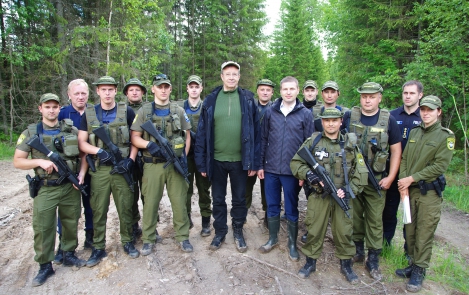-
Reset
+


President Ilves at the south-eastern border: a strong border guard and adequately protected border is a vital cog in Estonia’s security and one that is visible to all
15.06.2015
"You do a good job; Estonia can rely on you," said the President, Toomas Hendrik Ilves, who visited the border today to acknowledge the personnel who guard and protect the border of the Republic of Estonia along one of the most complicated sections.
The Head of State, who was accompanied by the Minister of Interior, Hanno Pevkur, and Director General of the Police and Border Guard Board, Elmar Vaher, inspected the section of border adjacent to Luhamaa, which has been cleared of underbrush and forest over the last year. Today, 72 km of the border has been cleaned and modern technical surveillance solutions have been introduced at the Estonian-Russian border in Võmmorski.
The length of the border between Estonia and Russia along the Narva River and Narva Reservoir is 76.7 km, 126.3 km on Lakes Peipus and 135.6 km on the mainland up to the Republic of Latvia.
The south-eastern border is also the most active section of border – due to illegal immigration, transit and smuggling – admitted the Prefect of the South Prefecture of the Police and Border Guard, Tarmo Kohv, and the Head of the Tartu Border Guard Office, Tamar Tamm. Last year, the border guard detained 90 illegal immigrants and identified 28 cases of illicit trafficking at this very section.
The total price for completing the construction of the south-eastern border and fitting it with surveillance equipment will be approximately 60 million euros.
"Domestic security is one of the components of the security of the Republic of Estonia that is visible and tangible for everybody, and this is represented by bringing together motivated, professional border guards and police with the Rescue Board," President Ilves emphasised.
The development of internal security and motivating the people involved will require full backing from parliament, just like the promotion of military national defence, stated the Head of State.
"In speaking about funding domestic security, we also mean investing in people and not solely concrete, vehicles or equipment," he stated.
At the meeting with land owners along the border, who came to the Koidula station building to meet with the President and the Minister of the Interior, President Ilves thanked the 73 individuals and companies who have so far agreed to co-operate, voluntarily, with the state on their border properties and allowed the establishment of the cleaned border zone.
"I am grateful to you; you are contributing to the better guarding and protection of both the border and Estonia. Large amounts of money spent on tanks or anti-aircraft systems only represent a fraction of national security," said the Head of State. "I am happy to see that our citizens understand that it is not only NATO that protects Estonia; there are some other threats such as illegal immigration or trafficking that we need protection against."
The Head of State today laid the corner stone of the new border guard cordon at Piusa, which will be completed by next summer and has sufficient space to accommodate approximately one hundred officials.
It is highly important to finally have a modern cordon established on this highly important and extremely sensitive section of the external border of the European Union; along with the Saatse cordon, this is one of the surveillance and quick response centres, said President Ilves.
Office of the President
Public Relations Department




